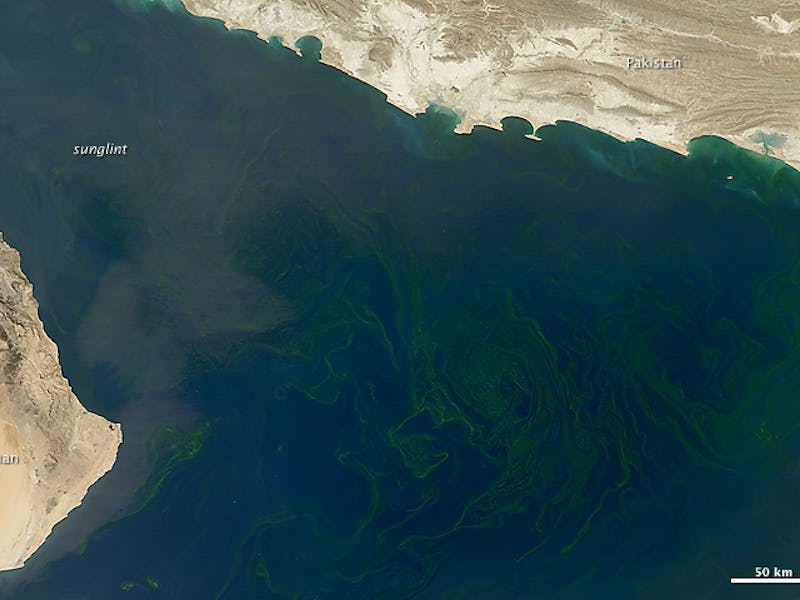Arabian Sea's Maine-Sized 'Dead Zone' Shows the Danger of a Bacterial Bloom
This sea is turning into a graveyard.

Diving deep below the blue-green waters of the Arabian Sea, Seaglider robots crashed headfirst into a wall of lifelessness. These robots, deployed by scientists from the University of East Anglia and Sultan Qaboos University, had found a “dead zone,” a region devoid of oxygen and, therefore, life. Publishing their work in a Geophysical Research Letters study last week, the team explained that dead zones occur normally — but this one, roughly the size of Maine, is nothing but normal.
“The Arabian Sea is the largest and thickest dead zone in the world,” marine biogeochemist Bastien Queste, Ph.D. said in a statement released April 27. In the paper, the team show that the Arabian Sea dead zone has grown significantly since it was first observed in the 1960s and then again in the 1990s. In the release accompanying the paper, the dead zone was described as being “larger than Scotland.”
Dead zones, or “oxygen minimum zones,” are often the result of human pollution, but they can occur naturally in the sea. In the case of the Arabian Sea, however, humans are almost certainly to blame.
Blooms of green phytoplankton are an indication that the Arabian sea is becoming more hypoxic.
Regardless of what causes them, dead zones are usually observed as a thick strip of water in the ocean, sandwiched between other layers of water with different density or chemical makeup. The one in the Arabian Sea was well known — it’s just massively bigger now — as is the one in the lower part of the Black Sea, considered by some scientists to be the largest naturally occurring dead zone in the world. In the United States, a dead zone in the Gulf of Mexico the size of New Jersey — about 9,000 square miles — is considered to be the largest. In all of these zones, oxygen is at a minimum or is completely absent.
It’s not an ideal situation for marine life, which is already threatened by warming waters as is. But human pollution — especially wastewater runoff from agriculture and industry — is making the problem unsustainable.
Pollution creates dead zones through a process called eutrophication. When the water is pumped full of nutrients like phosphorus and nitrogen — a big part of the runoff from fertilizer-using farms — it boosts the growth of naturally occurring blue-green algae called cyanobacteria. These little guys are fine when their numbers are kept in check, but when their populations spike, they wreak havoc on their surroundings. For one thing, cyanobacteria need to breathe, too, so they use up all the oxygen in the water. Then, because they grow in “blooms” so thick they can be seen from space, they cloud the sunlight from filtering down through the water from photosynthesizing ocean plants below, which are usually responsible for replacing oxygen in the water. Over time, as the algae use up all the oxygen and in doing so kill the only plants that can replace it, the water — and everything else in it — begins to die.
Huge cyanobacteria blooms in the Baltic Sea have turned it into a massive dead zone.
The same thing recently happened in America’s beloved Walden Pond, the inspiration for Henry David Thoreau’s legendary book. As Inverse reported in March, an excess of human activity — and output — is all it takes to kill a thriving body of water.
An uptick of phytoplankton, beginning in the 1920s, after the shoreline was developed for tourism, suggested that human activity was making the pond more habitable for those organisms. Phytoplankton thrive on phosphorus and nitrogen — which just so happen to be a big part of human waste.
Human excrement, just like fertilizer used in agriculture, is crammed with nitrogen and phosphorus, so any body of water that’s near humans who farm, urinate, and defecate — and are irresponsible about cleaning up — is a potential dead zone waiting to happen. Unless we clean up our act, the world’s oceans could soon become graveyards.